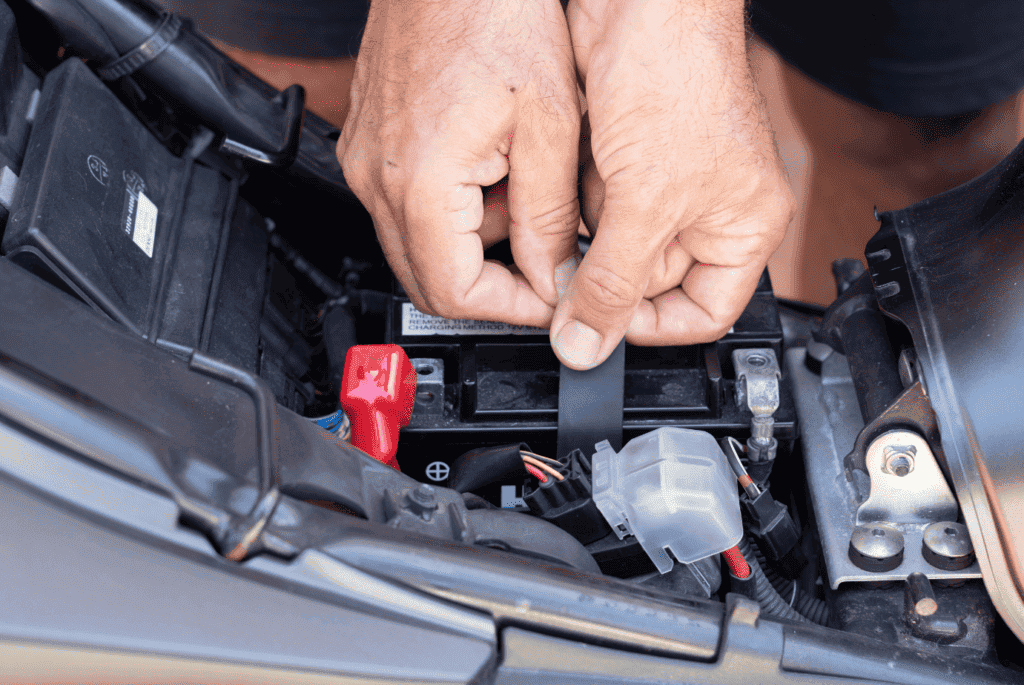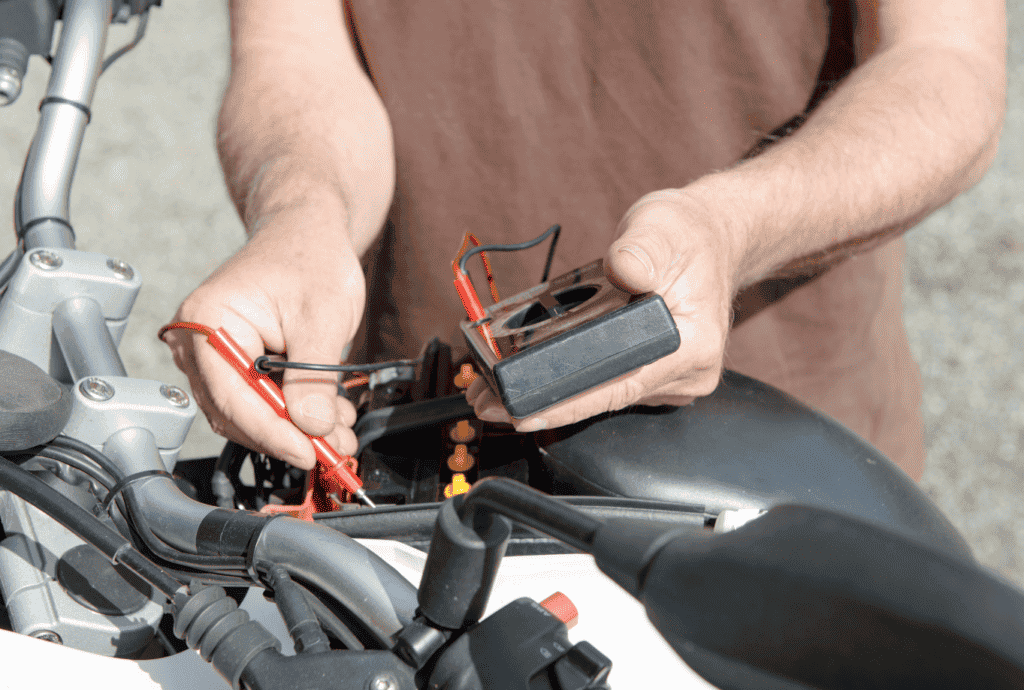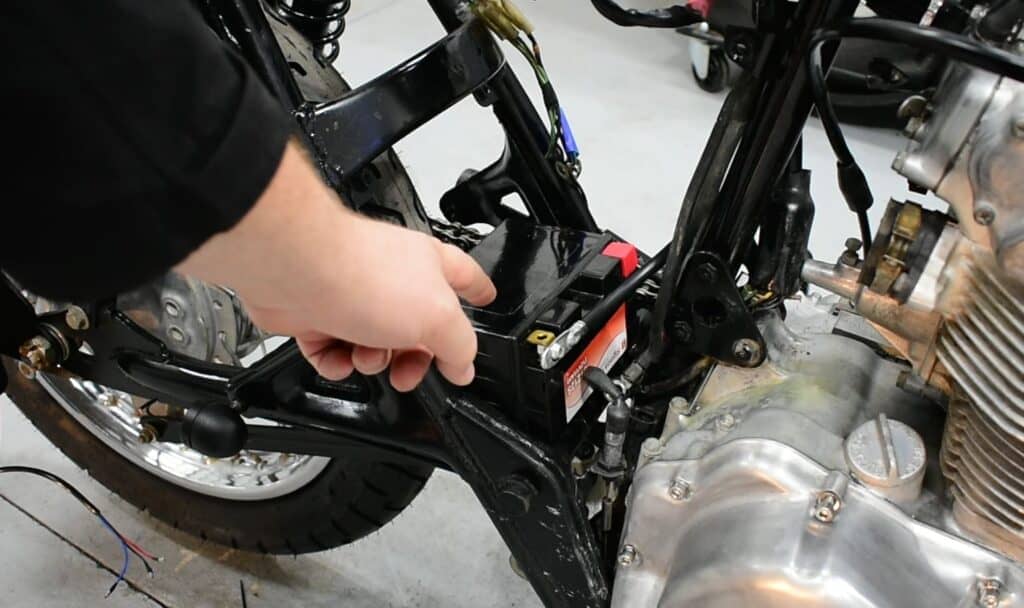
Your battery is one of the key components to a motorcycle that gets it up and running. Battery issues on a motorcycle are one of the most common types of issues to run in to and it can be incredibly frustrating. Knowing the signs of a dying battery is a great way to prepare as a rider and can prevent a lot of annoying scenarios down the road.
How can you tell if your motorcycle battery is going bad? There are several ways to tell if a motorcycle battery is going bad including a motorcycle not starting or starting weakly, bulges on the battery, corrosion on the battery terminals, low voltage or cranking amps from the battery, a clicking starter, or lights throughout the motorcycle flashing or dimming.
A battery going bad on a motorcycle is, unfortunately, inevitable. Batteries don’t last forever, and these are the tell-tale signs that yours is on it’s way out. We’ll help you understand how the battery works, the signs to look for, and what you can do as a rider to give yourself the best chance of uninterrupted rides!
The Basics Of How A Motorcycle Battery Works
Let’s explain basics of how a motorcycle battery works. That way you can follow along with the proceeding common ways to tell if your motorcycle battery is bad and you can better understand what’s really going on.
There are several different types of batteries a motorcycle may have including lead acid, lithium ion, and absorbed glass mat. The most common type of battery for motorcycles is the lead acid battery, but they all generally work the same way.
In a lead acid battery, a lead-acid technology is used to create energy through a chemical reaction. This is done by using cells that store and contain energy until it is needed. Inside the plastic casing of most motorcycle lead acid batteries, there are six cells placed in a row and contain a lead dioxide plate and a lead plate. With this combination, each cell creates 2 volts, hence the reason it’s considered a 12 volt battery.
All of these cells are surrounded by sulfuric acid in which a chemical reaction is created between the lead dioxide plate and the lead plate. Lead sulfate and ions are then created which start to freely move between the plates; this causes another chemical reaction, producing hydrogen and lead sulfate.
Electricity is created by the movement of these ions as they move between the positive and negative terminals of the battery. The wires that are connected to these terminals can then provide power to the vital electrical components of the motorcycle.
Bulges On The Battery Casing
Bulges on the battery casing indicate a failure with the electrolysis process; during this process, hydrogen and oxygen are released through an exhaust system or a “vent” (note that not all batteries have a venting system, but most do). Over time with the age of a motorcycle battery, this venting system may become blocked which leads the hydrogen and oxygen system to swell up inside the battery since it doesn’t have anywhere else to go. Multiple exposures to extreme temperatures can cause this too.
This will manifest itself through a bulge on the side of the battery. It is not safe to continue to use a battery that has bulges since it can rupture and spray sulfuric acid on you and/or your motorcycle. If your skin is exposed to sulfuric acid it can cause extreme burns. If it gets anywhere on your motorcycle, it can cause corrosion and ultimately cause damage.
Constant Buildup Of Grime Around Battery Terminals

You may have notice a strange buildup happening around the terminals on your battery. Sometimes it’s thick and black, sometimes it may feel a little sooty, but more commonly it’ll look like a white or light green foam forming around the terminals.
This is usually caused by a leak of sulfuric acid and/or hydrogen around the terminal area. The terminals are where you’ll find this greenish substance because there are different metals touching each other that interact with the leaking chemicals which causes this reaction. This may be an indication that the outside casing of the battery itself is failing and cracking which is causing those chemicals to leak. Unfortunately, this isn’t something you can fix and will require you to replace the battery.
Do keep in mind that some of this leakage is very normal. You’ll likely notice this greenish substance on your motorcycle battery terminals at some point throughout your ownership and that is okay! But if you’ve been cleaning it and notice the buildup again a few days later, then that’s when it becomes a problem.
Low Voltage Or Cranking Amps
Low voltage is one of the most common ways motorcyclists recognize that their battery is going bad. This is simply caused by age. After the sulfuric acid reacts within the battery so many times, it becomes “diluted” and doesn’t have the capacity to react the same way it did before while it was new. The plate inside the battery also will get a scale buildup on them and just can’t hold a charge like they used to.
This will often be indicated by not being able to start your motorcycle or constantly charging your battery because it can’t seem to hold its own charge.
Clicking Starter
A clicking starter coincides with low voltage or low cranking amps from your motorcycle. Again, this issue is usually caused simply because of the age of the motorcycle battery. Remember that the battery is responsible for starting the motorcycle, so that is why a clicking starter is directly correlated with battery health.
The starter on a motorcycle has a motor with a gear connected to it. When you push the start button on your motorcycle, that little gear that is magnetized gets pushed out and connects to the flywheel which ultimately starts turning and powering the engine.
If the starter starts clicking, that means the battery may have enough power to magnetize the gear, but it doesn’t have enough power to push it out and connect to the flywheel to start the engine. Essentially, the motor isn’t receiving enough amperage to turn the starter gear. It only has enough power to push the starter gear out and make contact (clicking).
Lights Sporadically Flashing On The Instrument Cluster
You may have noticed that the lights throughout your motorcycle have become dim or have a tendency to flash and flicker. This may be an indication that the battery on your motorcycle is going bad.
Lights sporadically flash, especially noticeable on the instrument cluster, because of low voltage on the battery. The computer on your motorcycle is trying to receive information and display that information on your instrument cluster, but because of the low voltage, it’s getting sporadic power and causes those lights to blink and flash.
These issues will manifest while the ignition is in the “on” position but you have not yet started the motorcycle. If you notice that the lights on your motorcycle are sporadically flashing or dimming while you are riding, there is likely another electric issues unrelated to the battery such as a problem with the stator.
How To Diagnose And Perform Tests On A Motorcycle Battery

If you suspect the battery is bad on your motorcycle, there are a few tests you can perform to confirm your suspicions. These are the tests I do and they’ve always told me exactly what I need to know about my motorcycle’s battery health.
The first thing you’ll want to do is a voltage test. You can easily do this by using a voltmeter or a multimeter (I usually use multimeters since it has other features that are useful in these situations). You’ll need to put the red lead on the positive terminal of the battery and the black lead on the negative terminal. Turn it to DC voltage on your multimeter. If the multimeter reads 12.6 volts, you have full voltage and it is completely charged.
Each .2 volts that you have means a 25% difference in charge. For example, if you have 12.4 volts, that means your motorcycle battery is 75% charged. If you have 12.2 volts, that means your motorcycle battery is 50 percent charged, etc. etc.
Keep in mind that just because you have voltage, that doesn’t necessarily mean you have enough current needed to start your motorcycle. Your battery may show that you have 12.6 volts, but not have enough current to start the starter gear. This is actually pretty common with old batteries. A bad battery will likely show itself through low voltage, but if you suspect the battery is bad and you still have enough voltage, you can have a test performed to show the current.
There are current draw machines, but they’re pretty expensive and most motorcycle owners won’t have one. The best way to test the current performance on your motorcycle battery is to take it in to a battery shop or an auto shop (like Autozone or O’reilly) and have them perform the test for you.
The current draw machine they use puts an electrical load on the battery and tests the voltage drop during this process. They can then calculate how many cold cranking amps the battery still has left. This test has been free for me every time I’ve taken a battery in to be tested. They’ll be able to tell you if the battery is bad or not (and you can request to see the results yourself if you’d like). The nice part is, if the your motorcycle battery is bad, you can just simply buy a new one since you’re already at a store that can provide one for you.
What Is The Average Life Expectancy Of A Motorcycle Battery?
You might be wondering how long you can expect your motorcycle battery to last for. This will vary some on different motorcycles, different types of batteries, the brand of battery that you buy, and how well you take care of your motorcycle.
In general, a standard battery will last between 2-5 years. An AGM battery lasts a little bit longer and you can plan on it lasting for between 3 and 5 years. Obviously, batteries of higher quality are going to last longer. That is why buying the cheapest battery isn’t always the best option. Additionally, doing things like deep cycling your battery, or letting it die, can greatly shorten a battery’s life.
What Can You Do To Prolong The Life Of Your Motorcycle Battery?

If you found out your motorcycle is bad and had to replace it, you may be wondering what you can do to prolong the life of your new battery. Batteries are expensive, so it makes sense that you wouldn’t want to buy one again any time soon!
One of the first things you can to to prolong the life of your motorcycle battery is routinely cleaning the battery terminals. As we previously mentioned, the sulfuric acid from lead acid batteries produces a buildup on the terminals which can reduce the contact between the cables and the terminals. This essentially causes an electrical resistance which makes the battery work much harder than it needs to.
To clean the buildup that appears on your motorcycle battery terminals, mix together some baking soda and water in a dish. Using either a wire brush or a regular toothbrush, brush away the greenish buildup on the terminals. I recommend having some protective gloves on and some protective glasses in case a piece flicks up in to your eyes. The baking soda will act as a neutralizer on the sulfuric acid, making it safer to handle. Don’t forget to clean the cable connections!
Once you feel confident the buildup has been brushed away, dry it was a shop towel or use an air compressor to air dry it. Ensure there is no water on the terminals before placing the cable posts back on.
Vibration dampeners placed around your motorcycle battery can also greatly increase it’s lifespan. Older motorcycles came stock with metal boxes for the batteries; these less-than-ideal circumstances can quite literally shake the life out of a motorcycle battery! Dampeners can be found anywhere online to fit your motorcycle.
If you live somewhere that gets really cold in the winter, use a battery tender with an automatic shut-off that will charge your battery during extreme cold weather. Cold weather has a huge impact on the life of a motorcycle battery and can quickly deplete it’s charge. Having that battery tender will not only keep up the battery healthy, but it’ll also get you on the road quickly!
Lastly, take preventative measures that keep your motorcycle battery from completely discharging. When you let your battery completely drain, all of the electrons essentially get pulled out of it. You’ll still be able to use your battery, but you cannot replenish all of the electrons that were there before.
As one of my professors once put it, think of it like unpacking a tent for the first time from a box. You use it for the weekend for a camping trip. You can place it back in the bag it came with, but you’re never going to get it small enough to place back in it’s original box that it came in. The electrons work in a similar way on a motorcycle battery if it’s completely discharged.
It’s not realistic for this to never happen, I’ve done it myself plenty of times. I recommend to just make an effort and avoid leaving headlights on and address potential parasitic drain that may be happening somewhere on your motorcycle.
How To Tell The Difference Between A Battery Going Bad vs. The Stator Going Bad
There may be some questions or confusion about whether the issues you’re having are coming from a bad battery or a bad stator. This is worth mentioning in this article because the symptoms of a bad stator are similar to the symptoms of a bad battery.
The battery on your motorcycle is what starts your motorcycle. Once your motorcycle is started, the stator is what takes over and recharges your battery and provides power to the rest of the electrical components. A failing stator will often manifest itself through a dead battery. This is because it’s not doing its job by recharging the battery after the motorcycle has been started.
Additionally, you may notice your motorcycle being sluggish during a ride and will likely worsen the longer you go. The lights will start to dim and your motorcycle will ultimately shut off. This is because you are solely running off of the power from the battery and not the stator; this is not the purpose of the battery and this can ultimately damage your battery, too.
Lastly, you may notice that your battery is getting very hot. While a battery getting hot is normal, excessively heat is not. This is usually not a symptom of your motorcycle battery going bad, rather it means a issue with the stator because it is providing too much amperage.
